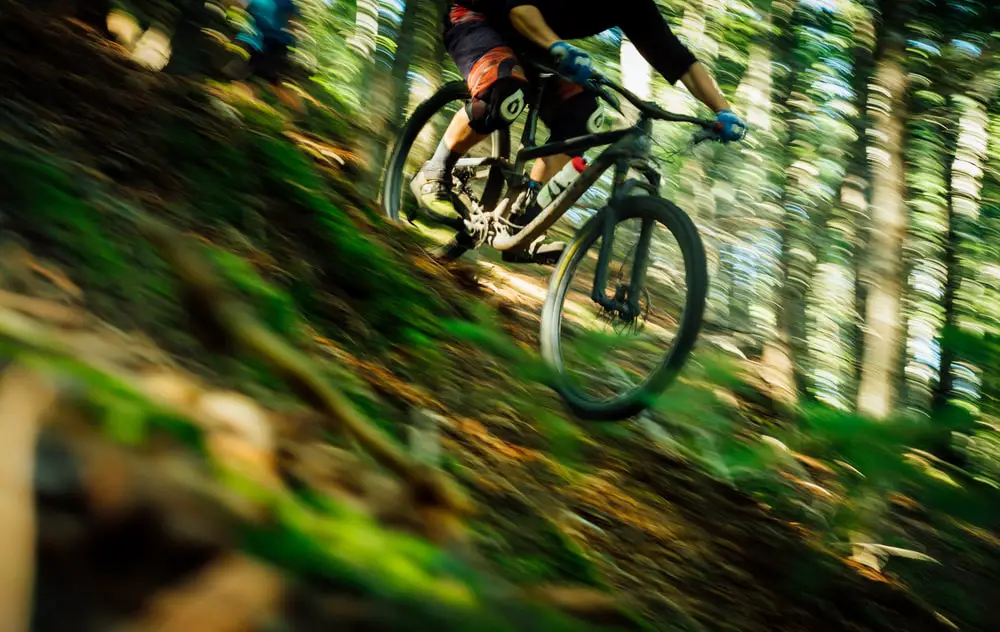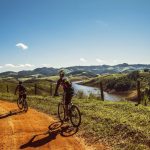Mountain biking encompasses a wide range of riding, from casual trail riding to high-speed racing and downhill. With their sturdy frames, fat tires, and advanced components, modern mountain bikes are highly capable machines built to handle almost anything the trail throws at them. But given their weight and design tradeoffs compared to lightweight road bikes, are mountain bikes actually fast?
Defining fast speed for mountain bikes
To answer whether mountain bikes are fast, we must first define what constitutes fast speed in the context of off-road riding. On smooth pavement, pro road cyclists can sustain over 30 mph using skinny tires and aerodynamic positioning. But determining fast speed for mountain biking depends on much more variable trail conditions, bike types, and rider abilities.
On a smooth dirt road, a fit cross-country or trail rider can achieve a brisk 20-25 mph pace using a lightweight short travel bike. Descending on intermediate singletrack, 15-20 mph is a quick speed requiring concentration and skill to pick fast lines while managing rocks and roots. For advanced enduro and downhill riders, hitting 30-40mph on steep bike park terrain with big jumps and berms is considered fast. So speed definitions depend heavily on context.
Ultimately, “fast” means different things to different mountain bikers based on their bike, skill level, and trail type. Smooth beginner dirt paths enable faster paces than steep, extremely technical terrain accessible only to expert riders. We must consider all these factors when evaluating whether modern mountain bikes qualify as fast machines.
Capabilities of high-performance mountain bikes
While heavy, long travel downhill and enduro bikes may not seem optimized for speed, modern high-end designs demonstrate the fast pace possible under the right circumstances. Elite World Cup downhill racers regularly exceed 40 mph during race runs down steep, groomed bike park courses using dual suspension bikes with over 7 inches of travel. The current downhill speed record exceeds 60 mph, though such speeds involve extreme risk and require ideal terrain.
Lightweight cross-country race bikes designed for speed over varied terrain have also illustrated the velocity possible off-road. Pro riders have been clocked at over 40 mph sprinting down smooth race course sections. And some backcountry riders have eclipsed 50 mph descending fireroads on longer travel trail bikes. So with enough gradient and dialed terrain, today’s cutting-edge mountain bikes allow riders to achieve road-like speeds. The difference comes in the incredible bike handling andadvanced technique required to stabilize and control that pace off-road.
No one would claim mountain bikes are as fast as road bikes across all conditions. But with strong riders aboard capable bikes designed for speed, mountain bikes can certainly qualify as fast machines depending on how we definefast within context.
Factors that impact mountain bike speed
To better understand if and why mountain bikes can be fast, we must consider the design factors that affect their speed. These include:
Rider fitness and skill
The most significant factor determining downhill speed is rider fitness, nerve, and bike handling technique. Generating power and using proper form to efficiently tackle technical sections without dabbing a foot or braking heavily conserves momentum. Expert riders ditch perceived limits and speed-scrubbing hesitations to rail terrain advanced riders or downhillers creep through. Fitness sustains high output and concentration managing variables. So two riders with a 50-pound weight difference can achieve very different top speeds on the same bike based on conditioning and capability.
Bike weight
Heavier bikes require more power to accelerate and decelerate rapidly. So while weight has less impact on top speed, lighter cross-country race bikes achieve faster pace exiting corners and covering varied terrain requiring rapid speed changes. Removing a few pounds saves seconds charging uphill as well. In smooth environments favoring momentum conservation, lightweight trail bikes carry speed better than heavy dual suspension rigs too. So while capable descenders can hit 40+ mph on burly downhill bikes, lighter trail and cross-country designs accelerate and handle more nimbly facilitating momentum better across undulating terrain.
Rolling resistance
Thicker, grippier mountain bike tires create more rolling resistance than skinny road tires, slowing acceleration and top speed. But some fast-rolling cross country and downhill-specific tires allow much faster pace than heavy duty tires designed purely for traction and puncture protection. Tubeless setups facilitate lower tire pressure too for decreased rolling resistance in addition to better grip, cornering precision, and pinch flat protection.
Aerodynamics
Standard mountain bike frames and riding positions for technical handling are not very aerodynamic compared to time trial road bikes. But elite cross country racers do adopt slightly lower positions focus on wind cheating frames and parts. Skin-tight clothing also reduces drag versus baggier apparel. So optimizing these factors enhances speed over flat or less technical downhill sections. However the primary demands of technical precision usually limit marginal aerodynamic gains given handling compromises.
Suspension quality
High performing suspension enables carrying momentum through chunky sections far faster than rigid or lower quality suspension bikes. Dialed, plush suspension provides both traction and control hitting big impacts and loading turns hard while preventing acrobatic crashes wasting speed. So good suspension generates confidence to bomb terrain where lesser bikes require heavy braking.
Component quality
Precision componentry also prevents speed bleed cornering and braking. Quality wheels and bearings minimize flex sabotaging power transfer. Powerful, modulated brakes spare excess speed shedding before technical sections. Low gears empower muscling steep pitches without dabbing. So while top-tier components may not directly enable higher top speeds, they facilitate better momentum conservation translating to faster overall pace.
Considering these speed factors, dialed trail or downhill bikes ridden aggressively by expert riders with fitness, skill, and commitment to perfect line choices deliver incredibly fast rides. Cross-country bikes may cover point to point faster across certain flatter or less gnarly terrain favoring raw speed. But downhill bikes charge fall-line terrain at velocities exceeding most motor vehicles given their capabilities and rider expertise.
So modern mountain bike technology specialized for speed or ruggedescent absolutely qualify as fast. But rider ability unlocks that velocity as handling technique must compensate for design trade-offs enabling rough terrain speed.
How conditions affect appropriate and possible speed
Both physics and trail conditions determine appropriate and possible speeds far more than bike capabilities alone. The steepest downhill grades enable the highest velocity. But sight lines, cornering grip, reaction times, and obstacle spacing dictate safe speeds as well. Two sections with the same pitch and surface can demand completely different pace choices based on other factors. And fitness variables cause different riders to approach the same sections differently based on skills.
Smooth dirt roads
Smooth, straight dirt road descents with good visibility enable the fastest downhill speeds, especially on long travel bikes. Heavy duty tires provide sufficient grip at speed while keeping the bike stable. Dirt roads facilitate gradual, controlled braking as well given longitudinal grip. Such roads serve as finish arena descents for many enduro races for this reason. Hardtail XC rigs maneuver quickly here as well with the smooth surface.
Buffed-out single track
Flowy, bermed singletrack trails in bike parks or buffed by rider traffic allow experts to link high speed turns together riding just off the brakes. Chance of encountering other trail users limits all-out speed. But the ability to rail berms and pump rollers to generate momentum enables skilled riders to descend faster than advanced peers. Such trails offer taste of downhill pace linked by handling demands.
Intermediate singletrack
Typical wilderness singletrack introduces roots, embedded rocks, and elevation changes that dictate more controlled speeds. The directness possible descending dirt roads disappears as riders must pick optimal lines avoiding obstacles. 10-20mph allows absorbing smaller hits without being ejected while managing drifts around corners over loose surfaces. Speed choice depends on sightlines, proximity to trailside hazards like trees or dropoffs, and rider reaction time should an animal appear suddenly.
Advanced Enduro and downhill
Steep grades exceeding 30 degrees with big jumps, drops and rock gardens push bikes and handling to their limits. Photos cannot convey the concentration managing extreme speed over constantly changing terrain and obstacle fields. The margin for error disappears entirely at 30+ mph through rock gardens where impacts can eject even skilled riders. Racing these sections tests fitness and nerve tuning out self preservation instincts in favor of commitment to optimal lines. Beautiful in hindsight, but overwhelmingly demanding in the moment.
In summary, conditions dictate appropriate speeds even more than rider or bike limits. Available traction, visibility, trail width, and obstacle spacing require judgment evaluating dozens of variables nearly instantly to ride at ten tenths without surpassing abilities. What’s fast for one rider could be ambulance ride slow for another depending on skills. This complexity around balancing thrill and risk while fully engaging the ride defines mountain biking for many.
Are advances making mountain bikes faster?
With each passing season, mountain bike technology evolves to enhance durability, capability, and also speed. Recent years have seen several key innovations allowing both cross-country and downhill bikes to achieve faster pace in the right hands.
Longer and slacker modern geometry
Contemporary trailbike geometry emphasizes longer front centers and slacker head tube angles improving high speed handling and stability markedly. By elongating wheelbases and shifting rider weight rearward of the front axle, the front wheel exhibits less tendency to flop or wander at speed. This lends confidence railing turns built up by preceding generations of steeper, shorter bikes. Modern enduro and downhill bikes push these concepts to new extremes, enabling sustained velocities even through incredibly demanding terrain.
Better suspension designs
As suspension quality and sophistication improve across disciplines, both pedaling efficiency and descending traction benefit – facilitating faster climbing and descending. Advanced dampers using complex shim stacks and adjustable ports provide tunable control for big hits without wasting pedaling power. Lower linkage driven single pivots isolate pedal forces from the shock better as well. Evolving metrics optimizing suspension kinematics for intended riding goals help specialized bikes descend, climb, and corner better than equivalent models from just a few years ago too.
Electronic shifting
Smoother, instantaneous electronic shifting delivery boosts both power application and momentum conservation by optimizing cadence while traversing sections requiring rapid gear changes to maintain speed. Riders can downshift approaching tech knowing gears will engage swiftly without concern of chains dropping. Better front shifting facilitates combining big ring power with sufficient bail out bailout gears for the steepest inclines encountered when trying to sustain speed climbing as well. Electronic groupsets reflect meaningful evolution enabling riders to achieve and sustain quicker pace.
More durable rubber compounds
Recent durable rubber compounds extending tire life span allow riding higher air pressures facilitating lower rolling resistance without quickly shredding tread knobs. New casings resist sidewall slices too letting riders push harder through rock gardens and other obstacles without flatting or jeopardizing handling. Together these extend speed potential over time by reducing puncture related speed checks.
Burlier bike frames and components
Increased frame stiffness provided by robust polygons, oversized carbon layups, and stiff thru axles translates more power into forward progress without wasting watts flexing inefficient suspension or frames. Upgraded suspension dampers and sealed bearing sets also prolong peak function translating to better continuous speed. So while heaviest downhill bikes may rely on rider strength for max velocity as always, they now maintain that pace longer between needing component rebuilds or replacements.
Wheel and tire expansions
New wheel size standards including mullet setups mixing 29 inch front and 27.5 inch rear wheels expand possibilities balancing traction, handling, strength for harder riding associated with faster descent. Experimenting with tires optimizing rolling resistance without fully sacrificing grip or damping for roots facilitate speed as well. Riders now enjoy more tuning options to optimize bikes for descending quickly. Component durability accommodates the forces generated without failing as quickly.
These recent mountain bike innovations collectively optimize both handling technique possible and power application translating to quicker rides. Racing constantly pushes suspension, geo and componentry allowing more confident, efficient, precise piloting. This progress expands the envelope of speed accessible on the mountain bike spectrum by enhancing stability, capability, and control required to balance velocity and risks hitting real world trail obstacles.
So modern MTB technology absolutely contributes to faster mountain biking – provided riders possess the willingness and skillset to fully utilize these machines in the environments which created such capable, composed speed.
In conclusion
Defining fast speed for mountain biking depends heavily on context – the bikes, rider ability, and trails involved. Smooth dirt roads enable paces road cyclists could relate to, while rugged wilderness terrain limits speed significantly. As rider technique develops and purpose-built bikes become more proficient, the concept of fast pace changes.
While aerodynamics and minimizing weight facilitate the raw speed of cross country bikes on certain terrain, modern geometry and suspension allow downhill bikes stable velocity through obstacles limiting other designs. No bike remains fast with riders exceeding handling limits though.
So skill unlocks speed as much as engineering. This truth keeps the art alive and exciting even as bikes progress tremendously. Are modern mountain bikes fast then? Absolutely – but rider input determines how fast. Both limitations and exhilaration emerge symbiotically when pursuing the limits of these amazing machines across the best riding landscapes.






